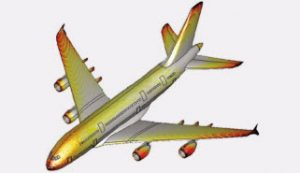This article was originally published in the June 2018 issue of SIMULIA Community News magazine.

On average, a commercial airliner will be struck by lightning around once a year [1]. A bolt of lightning carries thousands of amps of electric current and millions of joules of energy, and the aircraft needs to bear this without suffering either damage to its fuselage or interference to on-board electronic systems.
Traditionally, aircraft were made of metals such as aluminium and titanium, which are effective conductors and can tolerate lightning strikes without much concern. However, to reduce weight manufacturers are turning to composite materials such as carbon fiber. These are much less conductive, and provide less shielding for electronics inside. As a result, it is now more important than ever for aerospace engineers to understand how an aircraft behaves during a lightning strike.
Physical testing with a full-sized prototype is difficult, while scaled-down models don’t accurately capture how lightning behaves. EM simulation with a digital mock-up (DMU) is an alternative approach that offers engineers a fuller picture of exactly what happens to the aircraft during a lightning strike.
The first stage is lightning zoning, or attachment analysis. The electric field around a metal object is concentrated at sharp edges and points. The same principle that explains why it’s dangerous to put a fork or crumpled foil in a microwave oven also explains why lightning tends to strike aircraft on the wing, nose or tail. Electrostatic simulation on the aircraft model can locate the parts of the airframe which produce the strongest fields, and therefore the places where lightning is most likely to attach, helping inform the next stage of simulation: transient analysis.

A lightning strike may be over in the blink of an eye but it has distinct phases, with a very rapid increase in current, a peak, and then a slower exponential decay. Time domain EM simulation is therefore necessary to capture the full transient behavior of the lightning pulse. The lightning current is injected into one part of the aircraft, and allowed to leave through another.
The electric current on the skin of the aircraft can be monitored, as can electric fields inside. Often, fields enter the aircraft through very small features such as seams and cables. These crucial elements can be included in the CST STUDIO SUITE simulation.
The large currents seen during a strike can heat the airframe, and multiphysics simulation is essential to analyze this heating effect in order to verify the integrity of the materials. Coupled EM-thermal simulation takes the electric losses calculated by the time domain solver and uses these as the basis for further simulations to find the temperature change and heat distribution on the aircraft.
EM simulation offers an effective way to visualize and explore the effects of lightning on the aircraft from the earliest stages of development, and help engineers ensure their design meets the rigorous safety standards. The same principles can be applied to any structure that might be struck by lightning, including ships, rockets, wind turbines, broadcasting towers and buildings.
[1] “What happens when lightning strikes an airplane?”, Edward J Rupke, Scientific American
For More Information: www.cst.com/lightningattachment
